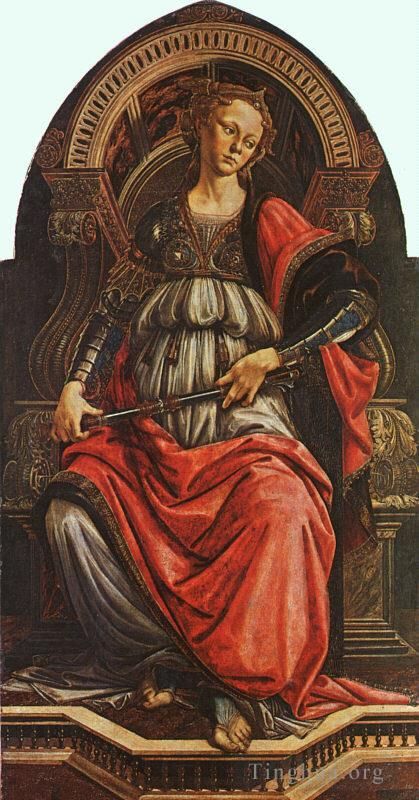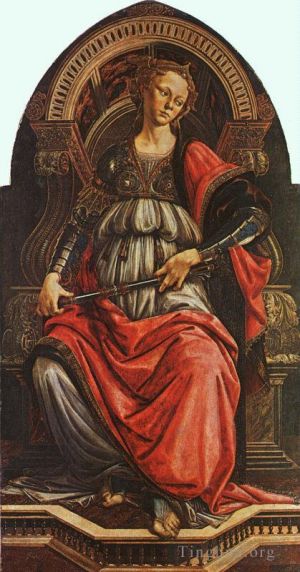Fortitude
Sandro Botticelli
- Price: Price on Request
- Art Type: Various Paintings
- Size:
- English Comments: 0
- International Comments: 0
- Creating Date:
- Introduction and Works of Sandro Botticelli >>
Keywords:
Fortitude
Work Overview
- Fortitude
Artist Sandro Botticelli
Year 1470
Medium Tempera on panel
Dimensions 167 cm × 87 cm (66 in × 34 in)
Location Uffizi, Florence
The Fortitude is a painting by the Italian Renaissance master Sandro Botticelli, finished in 1470. It is housed in the Galleria degli Uffizi, in Florence. Fortitude is the first recorded work by Botticelli.
This work originally belonged to a set of seven panels representing Virtues, intended to decorate the Tribunal Hall of Piazza della Signoria in Florence. The other six panels are painted by Pietro Pollaiolo's workshop.
Sandro Botticelli is among the greatest Renaissance painters. His first known, completed work is Fortitude, which is currently held in the Galleria degli Uffizi, in Florence.
Properly known as the “Allegory of Fortitude,” the painting personifies the virtue of in the form of a young woman sitting upon a thrown and holding a scepter as she gazes pensively to the right (her left). The painting is believed to have been completed in 1470.
Fortitude is among the four “worldly virtues,” along with Temperance, Prudence and Justice. They are matched with the three Christian values of Faith, Hope and Charity. A panel of these seven virtues was commissioned by the Commercial Courts of Florence, Italy.
quickly established the young Botticelli as an important artist and launched his career. It was his first paid commission. This work is most often described as “inspiring” by those who view it. The young woman is feminine, yet projects a sense of powerful, steady strength. She is adorned in flowing garments dominated by red, but muted with grays and browns.
Some say Fortitude appears pregnant, while others attribute the somewhat fulsome appearance of her midsection to the layered, pillowed style of clothing. Fortitude is a true masterpiece among an era when some of the world’s greatest art was produced.The painting was commissioned for the Tribunale della Mercatanzia (a court where crimes of an economic nature were judged) and it was Botticelli's most prestigious work of the 1470s. The entire series of Virtues had been ordered from Piero del Pollaiolo.
The figure of Fortitude is placed on a high throne with elaborately carved arms, a piece clearly traceable to Verocchio, but the feeling of tension that this thoughtful figure gives off surely comes from Antonio del Pollaiolo. The blue enamel work on the armour and the highlights on the metal are particularly interesting as they indicate a thorough knowledge of the goldsmith's art. The way in which the cloth is portrayed comes from Verocchio. The energy and vitality of the girl in armour, expressed in her face and her pose, is an original creation of Botticelli and shows clearly the very personal way in which he developed and enriched the styles of his contemporaries.
- Copyright Statement:
All the reproduction of any forms about this work unauthorized by Singing Palette including images, texts and so on will be deemed to be violating the Copyright Laws.
To cite this webpage, please link back here.
- >> English Comments
- >> Chinese Comments
- >> French Comments
- >> German Comments
- >>Report
- Pallas and the centaur
- The Calumny of Apelles
- Killing the woman (The Story of Nastagio degli Onesti - second episode)
- Nastagio meets the woman and the knight in the pine forest of Ravenna (The Story of Nastagio degli Onesti - first episode)
- The Birth Of Venus
- Primavera
- Discovery of murder Holophernes
- The banquet in the forest (The Story of Nastagio degli Onesti - third episode)
- Madonna And Child With An Angel 2
- Sandro Portrait of a young man
- Portrait of a young man
- Madonna In Glory With Seraphim
- The Temptation of Christ
- The Discovery Of The Murder Of Holofernes
- The Cestello Annunciation
- Adoration of The Magi
- Madonna della Loggia (Madonna and Child)
- Marriage of Nastagio degli Onesti (The Story of Nastagio degli Onesti - fourth episode)
- The Trials of Moses (The Youth of Moses)
- Madonna and Child with Six Saints (Sant Ambrogio Altarpiece)
- Portrait of a young man 1483
- Madonna And Child With An Angel
- Portrait of an young woman
- Venus and Mars
- Punishment of the Rebels (The Punishment of the Sons of Corah)
- Adoration Of The magi
- Madonna of the Rose Garden
- Simonetta
- Virgin and Child with an Angel (Our Lady of the Eucharist)
- Madonna And Child And Two Angels
- The Return Of Judith To Bethulia
- The Mystical Nativity
- Fortitude
- Sixtus II
- Guliano de Medici
- Madonna of the Book (The Virgin and Child)
- The Virgin And Child With Two Angels
- Madonna of The Magnificat
- Madonna with Child and five angels (The Virgin and Child surrounded by Five Angels)









 Singing Palette
Singing Palette